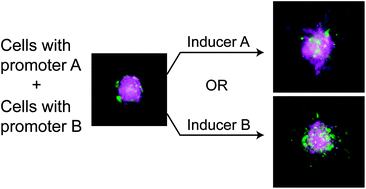Three-dimensional patterning of multiple cell populations through orthogonal genetic control of cell motility
Abstract
The ability to independently assemble multiple cell types within a three-dimensional matrix would be a powerful enabling tool for modeling and engineering complex tissues. Here we introduce a strategy to dynamically pattern distinct subpopulations of cells through genetic regulation of cell motility. We first describe glioma cell lines that were genetically engineered to stably express constitutively active or dominant negative Rac1 GTPase mutants under the control of either a doxycycline-inducible or cumate-inducible promoter. We culture each population as multicellular spheroids and show that by adding or withdrawing the appropriate inducer at specific times, we can control the timing and extent of Rac1-dependent cell migration into three-dimensional collagen matrices. We then report results with mixed spheroids in which one subpopulation of cells expresses dominant negative Rac1 under a doxycycline-inducible promoter and the other expresses dominant negative Rac1 under a cumate-inducible promoter. Using this system, we demonstrate that doxycycline and cumate addition suppress Rac1-dependent motility in a subpopulation-specific and temporally-controlled manner. This allows us to orthogonally control the motility of each subpopulation and spatially assemble the cells into radially symmetric three-dimensional patterns through the synchronized addition and removal of doxycycline and cumate. This synthetic biology-inspired strategy offers a novel means of spatially organizing multiple cell populations in conventional matrix scaffolds and complements the emerging suite of technologies that seek to pattern cells by engineering extracellular matrix properties.

- This article is part of the themed collection: Proteins, cells, and tissues in patterned environments

 Please wait while we load your content...
Please wait while we load your content...